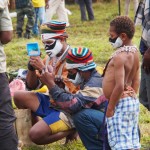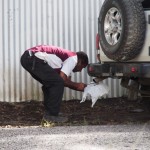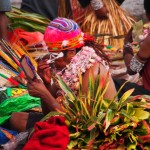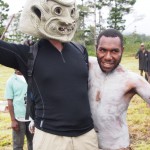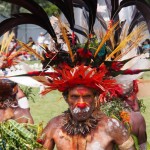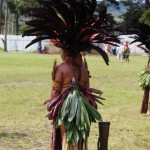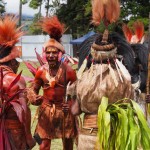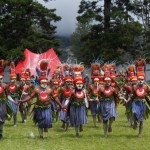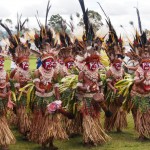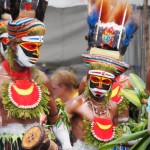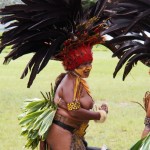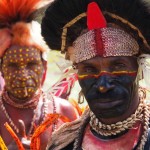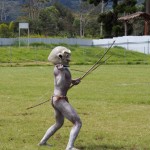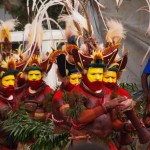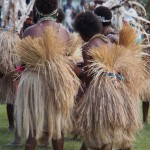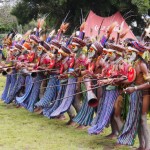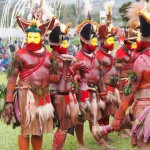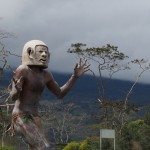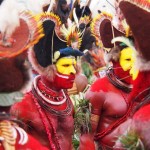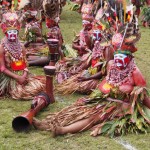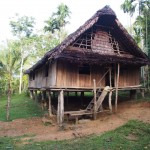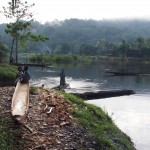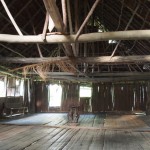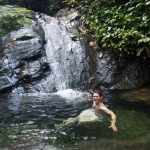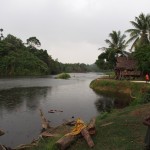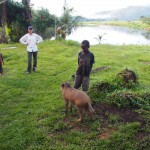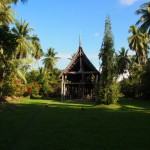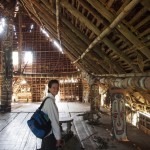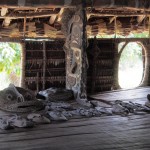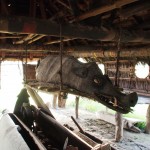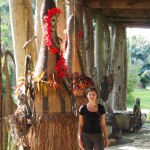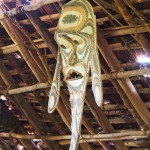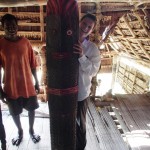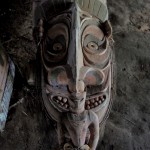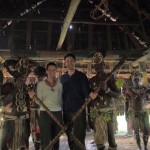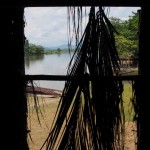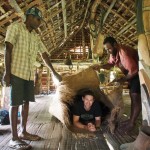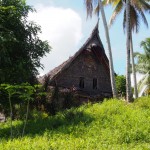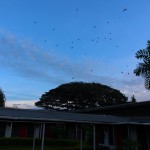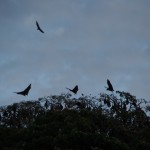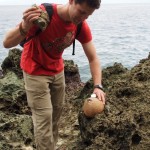Dancing, chanting, parading, marching. The amazing Mount Hagen show. The photos and the backgrounds only partially do the place justice – for that you might have to wait for the video!
Author Archives: James
The Mount Hagen Show
So, we finally move on to the Mount Hagen Show. The show, or Sing Sing as it is called locally, was one of the main reasons, if not the main reason, for us coming to Papua New Guinea. It was certainly why we were in the country on this date (and it had been difficult to schedule our flights around it) so we had dangerously high expectations.
ALL of which were met. The Mount Hagen show is absolutely, jaw-droppingly amazing. Hopefully the 20 photographs below (culled after long discussion and at great emotional expense from an initial 330 photos) will do the place some justice.
You stand in the middle of a rugby pitch surrounded by several hundred performers, all dressed up to the nines in banana leaves, bird of paradise feathers, full body makeup, masks, drums and sticks. All of them are dancing and swaying and marching and singing their hearts out. It goes on for two full days. It was only after a few hours of being overwhelmed by all this that we found out that half of the performers had actually stayed away. You see, their party had won the recent parliamentary elections, and they had stayed away for fear of violent reprisals from the losing side (welcome to PNG!).
The routine of the festival starts early in the morning, watching the performers arrive on the backs of buses and trucks and slowly metamorphosing from their usual street clothes into their performance costumes. Slowly the singing and dancing grows, before each group parades into the arena and joins an ever growing throng of pulsating, vibrant colour. At about 2pm the tourists and performers disperse – the tourists back to their enclosed hotels, the performers back into the surrounding shanty towns, from which loud chanting and singing can be heard late into the night. Despite Mount Hagen officially being a dry town (particularly around election season) the home brew industry must do a good trade at this time of year.
Alongside a relatively virulent strain of photographer tourist (see elsewhere) Mount Hagen also attracts a fascinating group of world travelers, amateur anthropologists and others attracted by interesting and difficult places. Our dinners in the evening were full of tales of tribal village stays in the 1960s, bushwhacking through WW2 trails in the deepest, darkest South Pacific and the occasional glancing reference to life on the ground during the Vietnam war. All pretty eye opening and awe-inspiring for a couple of humble office workers, I can tell you.
We wouldn’t have missed it for the world.
- Getting ready for the big performance – the white is Tippex, by the way
- Many ancient dyes and colours are used including, erm, exhaust soot
- Even while getting ready the performers were a blaze of colour
- James makes friends with the Asolo mud men as they get ready
- Awesome Old Dude. Old dudes are to Mount Hagen (and country music) what fat chefs are to cooking
- ‘Did you see those feather dancers? Like, erm, Tropicana dancers gone to seed’
- Aaaaaaaaaaaaaaagh!!!
- Chaaaaaarge!!!!
- In the highlands, sea shell necklaces are the most valuable possession and status symbol, which Australian gold miners used to their great (and unfair) advantage
- Father and son continuing the tradition. Artistique, eh?
- A riot of colour and movement and noise. And boobies
- James’s favourite photograph – in particular the fag and thumbs up from the guy in the background
- The Mud Men. They didn’t so much dance as freak the hell out of people
- The Tari Wig Men. Possibly the butchest wig-wearing men on the planet
- These guys were carrying a headdress which was best described as ‘like a mars lander’
- The Kilt Dancers. They carefully explained that there were three main types of dancing – standing in line, dancing in circles and jumping up and down
- Masters of the “jumping up and down in straight lines” dance. Awesome
- I want one of these for halloween. Just before we bought one we discovered they are made of unfired clay and don’t travel at all well
- I may try to steal this man’s facial expression for next time I want to, oh, sentence someone to death
- After the party. The expressions say it all
Tasting Notes – Banana Home Brew
So we are sat by the bank of the Sepik river at dusk, gazing out at the sunset and looking down at the deeply suspicious mineral water bottle beside us. Home brew is considered a scourge of Papua New Guinea, contributing to drunkenness, alcoholism, laziness and some pretty spectacular bouts of violence that occasionally flare up into tribal warfare. At election time the whole country goes “dry” with the only source of a drink being either overpriced tourist hotels or illicit hidden stills. It’s meant to be pretty vicious stuff. We HAD to try some.
Buying home brew on the Sepik is like being a teenager all over again. With the help of your guide you have to find a dealer who sells “the stuff”, get scoped out to make sure you aren’t “the Feds”, slip “Timothy” a ten kina note, hide the bottle in your pocket in case your guest house manager disapproves, find some coca cola to mix it with (of course avoiding questions as to why you suddenly need coca cola out in the bush), find a quiet place to drink it, get rid of the empties etc etc. Deeply sad I know, but it’s all actually really rather exciting.
So, the tasting:
- Initial appearance: mildly disconcerting, as it comes in an old 500ml mineral water bottle with a broken seal. Enough for four grown men, apparently
- Colour: clear, with perhaps a slight hint of oily murkiness. Although that could have been the old plastic bottle
- Aroma: surprisingly banana-y and aromatic, but with a hint of petrol. Which isn’t that surprising, given it comes from mashed up bananas left in a petrol can, then distilled using a rubber hose. A human taster takes the role of the perhaps-more-usual thermometer to make sure that it isn’t poisonous, but that it still has that home brew kick
- Taste: actually not that bad. There is clearly scads of alcohol there, but it doesn’t completely overpower the taste of bananas. It is most similar to rum, albeit with an unusual and testy zing which we attributed to the meths left over from the dodgy distilling process. Coca cola hides the taste of the meths pretty well, leaving a banana Bacardi & Coke taste. Mmmm.
- After effects: no doubt horrific, both in the hangover and going-blind stakes, but as professional taste testers without a spittoon handy we only had a small amount before handing the rest to our guide to dispose of as he saw fit
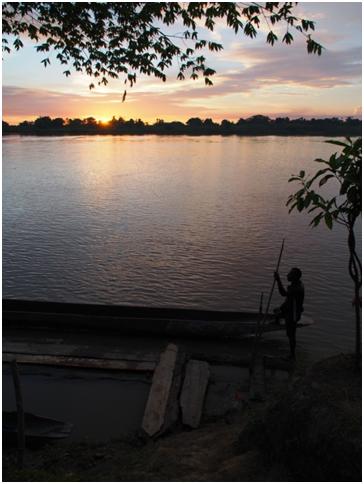
The view from our home brew spot (the local equivalent of behind the bike sheds, I guess)
Hotel Review – “Rodney’s House”
One of the joys of traveling is watching your own expectations shoot rapidly up and down the scale depending on your surroundings. In San Diego “Rodney’s House” would be a cheeky little boutique hotel built around a homely bar, perhaps with occasional winking references to Only Fool’s & Horses to titillate homesick expats. Rooms would be $175 a night and would come complete with retro hairnets in the shower and bangers & mash for breakfast.
On the Sepik, “Rodney’s House” was a house. Built by Rodney. Out of sticks.
We were two days into our trip down the Sepik River, and our guide Josh (whose professionalism was deeply suspect by this point, but whose honesty, charm and enthusiasm was not) was wondering where we might stay the night. Fortunately his mate Rodney had a house nearby, so we slept there. On the floor. It was great!
Dinner was a gourmet feast of eggs (boiled in a kettle) with Kwik-Kook noodles (using water from aforementioned kettle) and tinned tuna. From our experience on the Inca Trail, we were half expecting our (hired and paid for) cook to rustle this up for us. Unfortunately “Cook” was one of many Sepik euphemisms, and there was a comic interlude when we looked at Josh, he looked at us, we looked at him, he looked at Lucy (being a woman and all) and we decided to prepare dinner ourselves.
We had a beautiful view of the river which runs through the centre of the village, with local kids as young as three paddling dugout canoes back and forth. It rained gently, so we read until dusk, at which point we retired to our mosquito net in the corner and pulled our travel towels over us for bedding. The local dugout makers had stopped adzing tree trunks so the village was quiet, other than the local boar-pigs trotting around underneath the house rutting and scuffling into the night. We breakfasted by the river on peanut butter and jam sandwiches, washed in the local waterfall, packed up our motorized dugout with our daypacks and a few local carvings and we headed off upriver.
We loved it. Five stars.
- The Front Lobby – complete with 24hr local children concierge service
- The View. Unfortunately our room overlooked this busy street
- Spacious Rooms. Our bedroom is on the right. Our guides’ bedroom is on the left
- The Shower. Shared, unfortunately, and about 30 minutes away from the bedrooms
- The Hotel Pool, complete with floating reed island wetbar
- The Early Morning Alarm Call Service. Pigs are so much better than roosters
Spirit Houses of the Sepik
One of the main reasons we wanted to head down the Sepik is its reputation as the cultural treasure house of PNG. The villages are insulated from the outside world due to the difficulty (and, prosaically, expense) of getting up and down river. As a result, the Sepik is an area where tribal traditions are still kept very much alive, and nowhere is this more apparent than in the village Spirit Houses.
In the Sepik, gender roles are pretty well defined: women do the unimportant stuff (cooking, cleaning, farming, fishing, trading, looking after the children, managing the household finances) while men do the important stuff (chewing betel nut, smoking, carving the occasional crude statuette, discussing initiations and how best to placate the crocodile spirits this year). OK, so they also hunt from time to time, build the occasional house (once a decade or so) and hollow out the occasional canoe. Tough life, eh? So that they have an appropriate place to do all this important smoking, chewing and discussing, they build themselves a whacking great frat house in the middle of the village. Did I say frat house? Sorry, I meant Spirit House or – interchangeably – Men’s House.
There is probably some long, hack-journalistic riff I could carry on here about the amusing similarities between frat houses and Men’s Houses, but I won’t. To do so would be to belittle the Men’s houses, which are utterly spectacular. By far the largest structure in any village, they loom over ten meters high on heavily carved hardwood uprights, gables faced and crowned with sculpted eagles and wickerwork demons. Inside their dark and smoky interiors sit terribly, majestically scarred village men, their skin cut in literally hundreds of places during bloody teenage initiations which are virtually indistinguishable from torture. We don’t have any of our own photographs of these “crocodile skins” as we didn’t think it appropriate, but my God are they impressive in the flesh.
The rest of the Spirit House (all of which are utterly off-limits to local women and children) is full of ritual carvings, statues, masks, costumes, massive drums, spears and shields. The level of craftsmanship is variable, but can be extremely high. Everything on display is for sale, with the carver of each piece no doubt sitting within earshot chewing, smoking etc. and eager (but not undignifiedly so) for the cash. Needless to say we went a little crazy, coming out with two beautiful carvings, one statue and two ceremonial spears, all of which are currently on their way to my parents’ house in London (Hi Mum! Hi Dad!). Each village, although no more than a few miles apart, has its own distinct traditional style – the people at the post office were able to tell exactly where we had been by the carvings we were trying to send home.
- A spirit house – nice place to hang about smoking and talking rubbish (I mean, discussing matters of great masculine import)
- The upper, secret floor of a spirit house – you need to be a little careful not to fall through the floor
- Full of amazing carvings, and all for sale (the ancient, deeply sacred, taboo stuff is apparently hidden away from tourists)
- This … is a hat. Now, where did I put my Royal Ascot invitation?
- Lucy and Big Bird from Sesepik Street
- A spirit mask. Trick or treating in the Sepik must be fricking terrifying
- Lucy gets ready for war. Shame about the huge grin
- The head of a tribal garamut drum. Garamut, unfortunately, is also the name of the regional cash n’carry
- Ingratiating ourselves with the locals
- The view out of a window that women and children are forbidden to look into. Deep, man
- A traditional (family sized) mosquito net. Surprisingly cosy; smells like late summer
- An old men’s house in the hills – due for replacement. The house, that is, not the men
It was while we were sitting on the river bank drinking homebrew (see elsewhere for the suitably flippant tasting notes) that we had an exciting invitation. There was going to be a crocodile skin cutting ceremony in the neighbouring village the very next day. Would we be interested in attending? Bear in mind that these ceremonies involve bloody, lacerated, eighteen year olds screaming for their mothers while being held down by their uncles and sliced repeatedly with knives. While this isn’t normally something we would go out of our way to attend, given we were on the Sepik at the (pretty rare) moment when an initiation was taking place we couldn’t say no. Unfortunately, after an excited night we awoke to find out that the ceremony had been postponed by 24 hours. Would we be able to delay our departure for a day to witness it? This was, unfortunately, a hard No as we were due in Mount Hagen for the – even more spectacular – annual Sing Sing. So we declined, even though the invitation was repeated by the elders when we passed through the relevant village itself.
We make no bones about this in the other posts: travel in PNG is difficult, uncomfortable and expensive. But being able to see such extraordinary places, with ancient, alien traditions being kept alive in deeply taboo circumstances? Absolutely worth it.
Backgrounds – Sepik River
And so we move on to the Sepik River, home of ancient customs, sacred taboos and the world’s most bad ass dugout canoes…

Our valet, parking the car

Inside a men’s house. Taken by Lucy, a woman. Go figure.

Another busy day on the Sepik River
Joseph and Mary vs. PNG
Or: how we eventually found a hotel in Wewak (and no, neither of us is pregnant).
It has never taken me two days to find a hotel before. We turned up in Wewak with our trusty Lonely Planet in hand, hoping to find not only a hotel at short notice, but also a tour guide to take us up the Sepik river (of which more later). It was a relatively tall order, but one of the best known Sepik guides actually runs his own hotel, so we walked confidently past all the hotel taxis at the airport and strolled the short distance to the Surfside Hotel. Which was a series of portakabins sheltering under a three story building site (OK…), and which had nobody at reception (less OK…). So we waited, and waited, and tried the hotel next door (ugh), and waited, and it got dark. And you really don’t want to be caught out after dark. And here begins an epic story to rival that of the holy parents themselves. Laying it all out longhand would turn into a long list of and-then-we-did-this. So, a few selected and compressed highlights:
- Our initial rescue by a pair of scruffy good Samaritans with a Land Cruiser (one of whom turned out to work at Deloitte PNG, of all places) and driven to the best hotel in the country “where the white people stay”(!). The Inn Wewak Boutique Hotel is actually reasonable value at US$200+ per night but was deemed a little too expensive so we resolved to try again the next morning
- Discovering that the hotel we had targeted as a cheaper alternative was – how shall I put this? – a brothel full of drunks. Complete with complementary condoms in the rooms. Nice! And great value at US$175 a night
- Not being let past security at our next choice of hotel – we clearly looked undesirable (perhaps they thought I was a drunk, and Lucy was, erm, also a drunk)
- Eventually finding Francis – our saviour and the owner of the Eden Blooms Transit Inn. Deaf as a post, deeply eccentric (i.e. he had a fully equipped kitchen, missing only an oven or stove of any kind) but good to us. There was no hot water, and you had to be careful not to fall through the floor in places, but it was cheap at the price ($US60 a night). We didn’t have the heart to tell him that in the UK a transit house was a place where ex-convicts were rehabilitated, and that this was perhaps impacting the tourist trade just a little…
- Shocking the staff at the posh hotel so much by our exploits that when we returned a few days later – stumbling out of the jungle, hungry and unshaven with armfuls of native carvings and desperately in need of a shower that didn’t come out of the river – they automatically gave us a 20% pity discount. But that is another story.
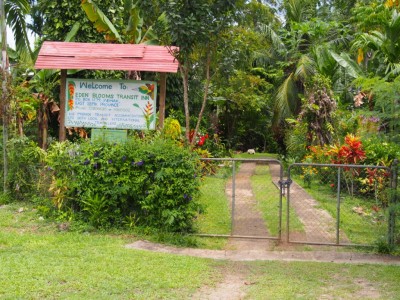
Our eventual hotel. The sign says “One person (given a mattress on the floor) – 60 Kina”. Class!
Our eventual hotel. The sign says “One person (given a mattress on the floor) – 60 Kina”. Class!
Bats and Coconuts – Welcome to Papua New Guinea
When we set off from NYC back at the end of May, one of our observations was that there was no hard start to our trip. We drifted away from the very familiar surroundings of the East Coast into gradually more unusual places. Regular subscribers (all 27 of you! Hurray!) may remember this post from back then describing how it felt. Had we started in PNG, all of that pseudo-intellectual musing would have been moot. PNG is different – very different. We are actually writing these posts in the Solomon Islands, having left PNG (we always stagger our posts a little behind time to allow a buffer for inevitable internet blackouts) and we have now had at least some time and distance to digest the trip. What will follow is a mix of the usual frivolous nonsense and at least a couple of relatively thoughtful notes on our impressions of the country. PNG certainly makes you think. We had an amazing time there, and would recommend it whole-heartedly to some of our friends.
Anyway, back to the good stuff:
We arrived in Port Moresby on a flight from Cairns and (following good advice from people we trust) immediately left town without setting foot outside the airport. The best hotel in Port Moresby is actually situated just beside the airport, and is designed to allow travelers to pay a hefty premium have absolutely nothing to do with the capital city of PNG (we will post on our return journey another time). We had selected the sleepy seaside town of Madang as our first stop, based on which flights had the shortest connection in Port Moresby, and arrived later that afternoon wide eyed.
Bats, sir. Thaasands of them. Where you might normally expect gulls in a town by the sea, Madang has bloody great fruit bats. They roost hundreds at a time in bloody great trees when they aren’t flocking around in dark, ominous-looking, bloody great clouds. (Interesting Galapagos-type factoid: there seemed to be no bat poop under the roosting trees, perhaps because they roost upside down?). Apparently they taste pretty good, but we didn’t find anywhere which served them. Instead we ate at one of the best-rated restaurants in PNG (no joke) – a walled-off part of corrugated iron shed called “Eden”, which couldn’t have looked less pre-possessing if it tried but which served a mighty fine rendang.
- Bats, sir. The view from our hotel room.
- Zoomy zoom on a bat roost. We STILL love our camera
- James gets a boyfriend point for bashing open Lucy’s first coconut. Also does cockroaches
We are trying hard to avoid “been-there-done-that-itis” where our blog is simply a teenage diary-style list of things we have done. It is going to be hard for PNG, given the amazing s*** we got up to. Let’s just say, after a day of walking around town, sipping beer and eating coconut flesh, we decided that Madang wasn’t sufficiently intrepid. Next stop the Sepik River!
Modern Life is Rubbish
Normally progress works forwards, right?
There have been a number of occasions on this trip where we have been forced to question this assertion. One example: since Lucy was last here, local-character-suppressing globalization has well and truly arrived in South America, Venti Starbucks in one hand, slice of traveler-pleasing pizza in the other. On the other hand, wifi is now ubiquitous, which is pretty cool.
The most egregious example of modernity making things worse, however, came in Santiago de Chile. We had decided to stay in an “Aparthotel”. Strangely this turned out to be unlike the excellent New York Aparthotels in which Lucy and I did our investment banking training in 1999 (thank you DLJ; thank you Wasserstein Perella). I won’t go into the grotty, soulless details here for fear of depressing myself and boring you. Let’s just say that the biscuit was well and truly stolen by the well-advertized “free breakfast is included”. Behold:
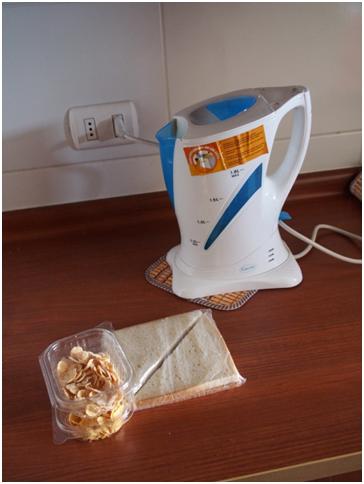
Two (2) shrink-wrapped single slices of plastic white bread and two (2) small plastic-wrapped single servings of cheap corn flakes. Not shown were two (2) plastic-wrapped single servings of UHT milk and two (2) plastic-wrapped single servings of processed orange juice. As we declined this feast on day one, on day two the machine provided us with a total of four (4) shrink wrapped slices of plastic white bread etc etc. I never would have thought it possible to become so deeply depressed by someone giving me free food. I just suspected that if we had died in there we would have ended up buried in the stuff before anyone noticed.
Aaaanyway, we de-funked ourselves, headed over to the old fish market to eat our bodyweight in El Bouillabaisse, watched the Olympic Opening ceremony on TV (Mr Bean! And the Actual Queen! With James Bond!) and took ourselves to an excellent steak restaurant to drink red wine and eat our bodyweight in El Filet Mignon. Next stop Sydney!
Handicap Cocktail Making
No, it’s not what you think. Although the mind does boggle slightly.
Among the things I miss most about our apartment in New York is my cocktail kit. Nothing fancy: a simple Boston-style shaker, a solid bar glass, a measure, a strainer and a freezer full of cold, hard ice next to a good-sized sink with running (and, er, drinkable) water. That, and a shelf of sporadically gathered bottles of booze and a bowl of fresh fruit. I’m very happy to improvise in less ideal circumstances, however, and our trip has already been livened up by the occasional scratch Pisco sour and one deeply confused Qantas air steward facing a request for ginger beer, a shot of dark rum, and a fistful of lime slices.
Airline lounges, however, present a specific problem. Good ones raise the spirits with an array of fine bottles of booze and lots of shiny glassware, but there are often strange holes where delicious drinks might otherwise be: only tiny slices of lemon (for example) or nothing to improvise a shaker out of, or if there is a shaker (hello LA!) no sink to rinse if out. We have often been reduced to drinking straight champagne which, as you can imagine, is a deep penance.
So, with no further ado, here is the list of cocktails that you normally can make in airline lounges (and thank you once again, dear employer, for granting me my BA gold card with all that transatlantic travel!)
- Firstly, anything you can get served in your university bar: gin ‘n tonic, vodka ‘n tonic, rum ‘n coke, vodka n’coke, whisky n’water blah blah blah boring boring boring. (although for those who haven’t tried dark rum n’tonic it actually works surprisingly well)
- First call, therefore, is an improvised classic champagne cocktail: sugar from the coffee counter sachets (in place of cube sugar) a half shot of good cognac and top it up with the ubiquitous champagne. See photo below, however…
- Tequila sunrise. Old school! There often seems to be grenadine in these places for some 80’s reason. And always tequila, and always bottles of plastic orange juice. Result! (particularly if you happen to be in Miami and therefore able to get away with it, which we were)
- The classic martini. There’s always gin / vodka; there’s always martini; there are usually olives. The only challenge is finding enough ice to make the damned things cold enough to drink without wincing
- Prepared beers. OK, so these haven’t really caught on outside that weird restaurant on the Lower East Side. Beer (preferably Mexican), lots of tabasco, tequila, salt and pepper. Let’s just say it’s an acquired taste, but actually rather good with food
Beyond that you start to struggle. That said, I guess we do have a while yet to perfect this strangely specific life skill. Any further suggestions on a postcard please!
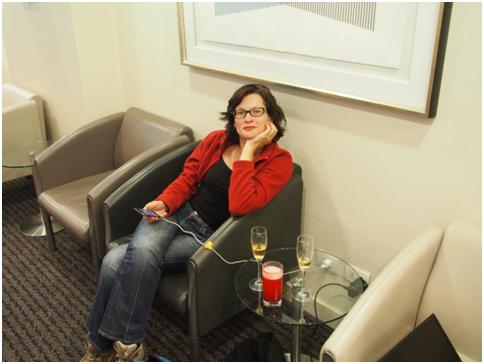
(on tasting) “Hang on, are there angostura bitters in this champagne cocktail?” What a great girl!





